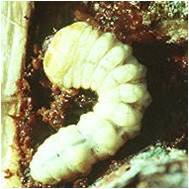Pests of Cashew :: Major Pests ::Stem and root borer
1. Stem and root borer: Plocaederus ferrugineus (Cerambycidae: Coleoptera)
Distribution and status: South India and Maharashtra. Major pest
Host range: Cashew, Moringa, silk cotton and citrus trees
Damage symptoms
Grubs bore into the bark in their early stages and make excessive tunnels in all directions causing wilting of branches and then the tree as a whole. Roots are also affected. Plantation over 15 years are often seen infested.
|
Bionomics :
Ovoid, dirty white eggs laid under loose bark in their early stages and into the wood in their late stages. Egg period 4-6 days. Full grown grub measures 7.5 cm and tunnels its way into the root region, grub period 6-7 months. Pupation occurs in a calcareous pupal chamber and pupal period 60 days. Life cycle completed in one year. |
 |
Management
- Undertake periodical cleaning of collar region, removal of grubs, pupae and eggs and inter ploughing wherever possible during monsoon months.
- Uproot and remove dead trees from the plantation
- Avoid injury to the trunk or exposed portion of the root.
- Swab the bark of the exposed roots and shoots with carbaryl 50 WP 2 g/L, lindane 20 EC 1 ml/L
- Swab with kerosene - coal tar mixture (1:2) upto one metre height on the trunk and on exposed bark after shaving the infested bark to prevent egg laying.
- Carry out root-feeding with monocrotophos (10 ml) + water (10 ml) in a small polythene bag twice a year on both sides of the trunk.
- Place carbofuran 3 G 5 g or inject 10 ml monocrotopos 36 SL and plug with mud to kill the grubs.
- Follow padding method of insecticide application with monocrtophos 36 SL 10 ml (Remove 5 cm2 bark at 30 cm from the base, place absorbent cotton dipped in 10 ml monocrtophos 36 SL and cover with mud).
|
|

